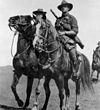Wikipedia:Today's featured article/July 30, 2011
The use of horses in World War I reflected a transitional period in the evolution of armed conflict. Cavalry units were initially considered essential, but the vulnerability of the horse to modern machine gun and artillery fire eventually fostered interest in mechanized forces. All of the major combatants in World War I began the conflict with cavalry forces. Germany and Austria-Hungary stopped using them on the Western Front soon after the war began, but they continued to be deployed in a limited fashion on the Eastern Front well into the war. On the Allied side, the United Kingdom used mounted infantry and cavalry charges throughout the war, but the United States used cavalry for only a short time. Horses were mainly used for reconnaissance and for carrying messengers, as well as to pull artillery, ambulances, and supply wagons. The presence of horses often increased morale among the soldiers at the front, but contributed to disease and poor sanitation in camps. The value of horses was such that by 1917 it was made known to some troops that the loss of a horse was of greater tactical concern than the loss of a human soldier. Ultimately, the Allied blockade prevented the Central Powers from importing horses to replace those lost, which contributed to Germany's defeat. (more...)
Recently featured: Christopher Smart's asylum confinement – Jack L. Warner – Point Park Civic Center

